The Ultimate Guide to Window Sills
Windows have been around pretty much since humans began building. As a feature allowing light and air circulation, primitive windows were merely small openings in the walls. However, as centuries went by and technology evolved, windows became one of the most dominant elements of a build, both at a structural and a visual level. And that, of course, includes window sills!
On this ultimate guide to window sills, you'll get answers to your most pressing makeover questions and a buying guide to The Skirting Board Shop's top options. We offer prime quality at affordable prices, plus you can get expert advice from our dedicated, top-rated team.
What Are Window Sills?
Window sills are both the internal and external pieces of moulding sitting just below a window frame's bottom section, between the glass and the wall.
Depending on where you are located, the term 'window sill' could be used to describe only exterior mouldings. As an example, in the United States, the internal sill is typically known as 'stool.' In some cases, UK manufacturers would call it 'cill' or 'window board.'
To keep things clear, know this guide dives right into the secrets of interior window sills - easy!
What Is the Purpose of a Window Sill
A window sill is one of the elements that make up a window frame. As such, it's designed and placed to hold together the whole structure of any given window.
It helps stabilise and absorb level changes on your openings, keeps water outside of your home and seals the wall cavity on the foot of your windows.
Another key protective trait of sills is how their overhang keeps your glass from the risk of being shattered by, let's say, someone tripping in your living room.
However, not everything is about structure! This simple piece of moulding can serve as a shelf, a storage unit, a window garden, or even a workspace. Yes. Window sills hold huge decorative potential, it's up to you to unlock it.
At the end of the day, keep in mind there's a reason why every single house around the block has window sills!
How far Should a Window Sill Stick Out?
The width of your window sill will depend on the thickness of your wall window jambs. When it comes to the overhang, this can easily range from 2 to 10 and even 20 cm.
How Long Should a Window Sill Be?
Your sills are inserted below your frames and window architraves. So it's recommended to pick window sills that are between 3 to even 15 cm longer than these. Clearly, this will depend on the overall size and design of your windows, and the right weight distribution to keep it all together.
What Are the Main Parts of a Window Frame
There are many distinct kinds of windows around the UK, being Casement and Slash the two most widely used. Still, the terminology to describe the basic structure of either is pretty much the same.
Why would you want to know this? Simply because when you are undertaking a DIY revamping project -or having a chat with your builder- you need to understand how all pieces stick together.
The head, jamb and sill make up the overall structure of a window frame. The head is the top part, the jambs stand tall on the sides, and the sill, as you know, sits across the bottom. The casing -aka architraves- refers to the pieces of decorative moulding surrounding the windows. This includes the apron, which is the strap placed underneath the window sill.
Choosing and Decorating Window Sills
Average wall thickness around the UK is between 25 to 36 cm. Typically, your window frames would be sitting halfway between the interior and the exterior of your walls. This means that a 150 mm window sill would give you, roughly, a 30 mm overhang, and a surface of 120 mm -remember your sills are inserted underneath the frame.
So a big part of choosing your window sills is to figure out the overall look you want your interiors to have, and how much space you want to create with your sills!
As these simple pieces of moulding make up a flat surface right where your windows are, they can easily enhance your decor with little to none investment at all. You can create a herbs garden, add glowing fairy lights, candles, cushions if space allows...just get creative!
You may also choose to combine different types of window sills depending on the needs of each specific area of your house. The distribution, orientation, and size of your windows also play a part together with the profile of your architraves.
Generally, bathrooms and kitchens would use subtle sills with minimum overhang, where master bedrooms and living rooms usually call for wider sills.
What's the Difference Between Internal and External Window Sills
The primary function of an exterior window sill is to shed water off your windows and protect the openings around your house from changing weather. Still, exterior window sills are also used for decorating a home's facade!
Due to their high level of exposure, the most widely used materials are weather-resistant uPVC, concrete, and timber.
As you can see, the main difference between an exterior and interior window sill lies on their functionality, material, and weather exposure. In the end, both will help support the structure of your frames together and keep your house safe and moist-free.
At What Angle Should a Window Sill Be?
Let's clarify that interior window sills shouldn't be angled, they are fine just sitting flat on the bottom of your windows. This question that we see pop up from time to time refers to exterior window sills, which should be angled at 15º to repel rainwater -this is called a drip edge.
The 5 Best Types of Window Sills
- Best for...discreet and simple finishings: Window Board Nosed and Tongued 25mm x 144mm
- Best for...interior design and creating ambience: Window Board Nosed and Tongued 25mm x 294mm
- Best for...a light touch of wood: Veneered American White Oak Window Sill
- Best for...top elegance: Veneered American Black Walnut Window Sill
- Best for...a classic country finish and period home renovations: Mahogany Foil Window Sill
1. Best for Simple Finishings --> Window Board Nosed and Tongued 25mm x 144mm
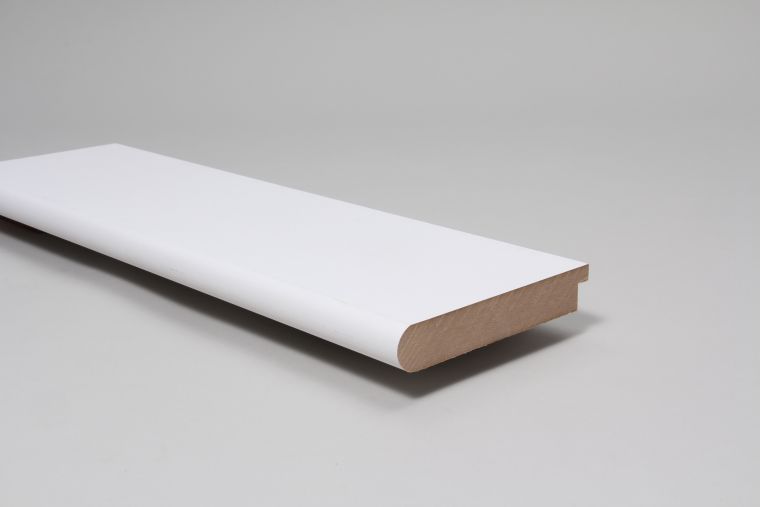
This white primed, nosed window sill comes ready for you to undercoat and gloss. All our sills have rounded edges to avoid sharp corners and to give a delicate finishing.
The width of this sill is 144 mm, which is the standard for most builds, especially around kitchens, bathrooms, small bedrooms, and offices. Those with thicker walls or keen to have just a little bit more of space should go for our 168 mm window sills.
A great perk of a white primed, narrow board is that it can't go wrong! You can choose a finish that matches your interiors, or just paint it on a different shade to match the rest of your mouldings and architrave.
The Skirting Board Shop MDF window sills are moisture-resistant. This means they not only withstand humidity but also repel the formation of moss on the base of your windows.
2. Best for Interior Design and Ambiance -->Window Board Nosed and Tongued 25mm x 294mm
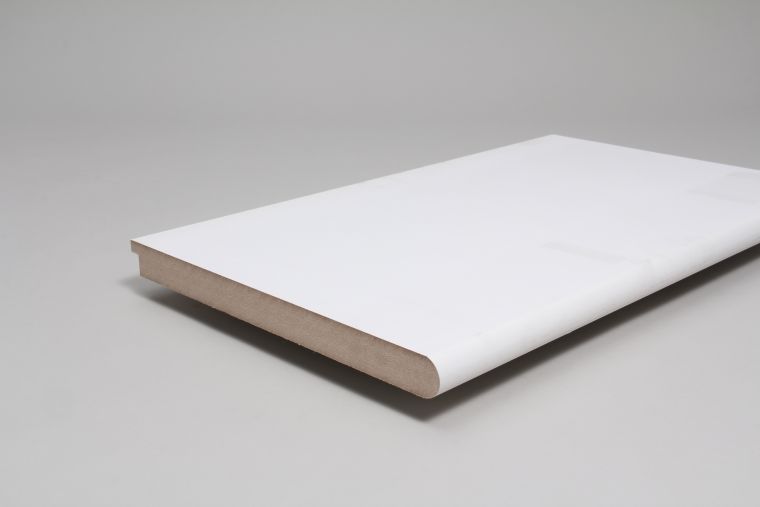
If you want your window sills to become visual focus points, or if you have a deeper window base to cover, then explore our range of wider boards! At 194 mm, 244 mm, 269 mm, and 294 mm, you can get as creative as you want.
Breathe life into your interiors with popping colours, statement pieces, or your very own window coffee table. Contrary to what you may think, you don't need to have a huge space to make the most of this type of board. Small apartments can also benefit from the extra storage space.
What's more, if you decide to keep these white, you'll be helping distribute the incoming sunlight from your windows. White surfaces are reflective, so wider boards equal...a larger reflective area!
3. Best for a Modern Twist --> Veneered American White Oak Window Sill
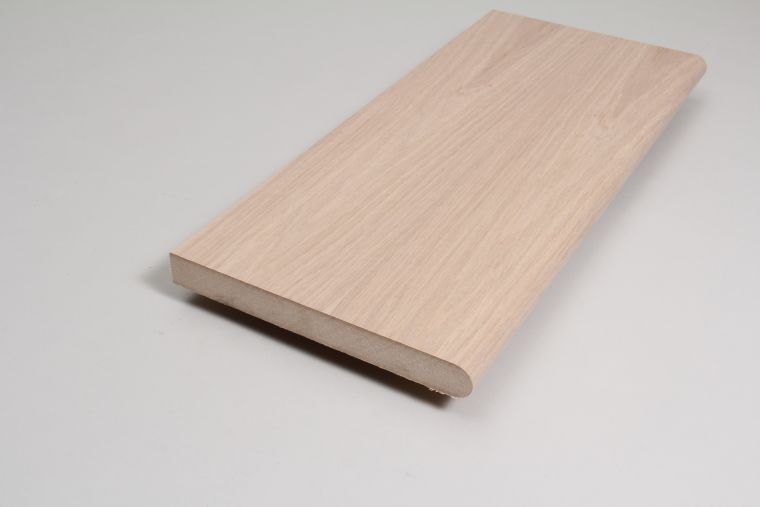
How could you not love the warm touch of wood in an interior? Nowadays, with design delving into Scandinavian Minimalism, shades of white and soft grey; plus the accents of light wood in furniture and mouldings, have become standards of modernity.
The pale-yellow brown tone of the American White Oak is the perfect match for contemporary spaces featuring sleek lines. At The Skirting Board Shop, you'll find our line of unfinished Veneered American White Oak sills in a range of widths such as 144 mm, 219 mm, 244 mm. All boards come prepared to get the final wax, oil or lacquer finish to match the mouldings around your property.
The high quality of these MDF veneered boards provide a real wood effect, but on a budget!
4. Best for Top Elegance --> Veneered American Black Walnut Window Sill
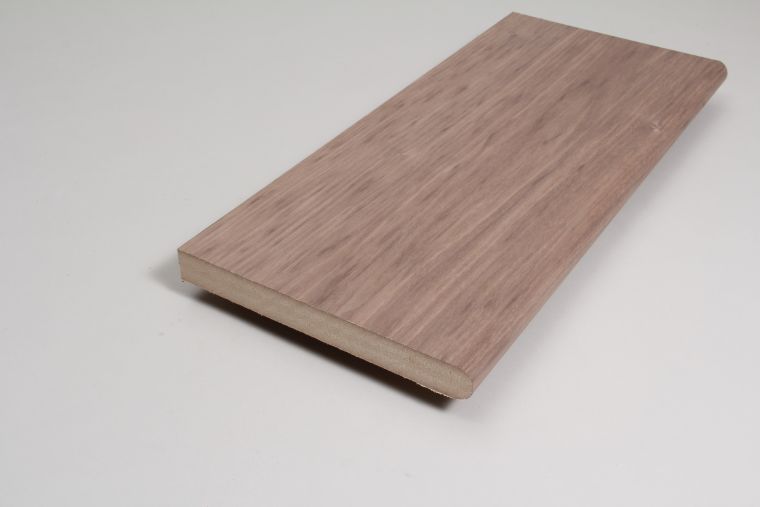
Black Walnut interiors are the epitome of elegance and character. Capable of 'dressing up' your rooms, this type of wood can be found in flooring, kitchen cabinets, wardrobes, and, of course, mouldings.
For a real wood timber veneer that can resist high levels of moist, or complement the style of your house, The Skirting Board Shop offers 219 mm and 244 mm Black Walnut window sills.
These nosed window boards are supplied unfinished for you to finish them to taste. Black Walnut interiors are sophisticated and can be present just as a slight dark-ish accent, or as a full-on monochromatic design trend.
However, modern houses are not the only ones that can make the most of Black Walnut! This was one of the most widely used types of wood in the Victorian Era, so it's also a superb choice for period homes refurb projects.
Give your sills a matte or rustic finish, or let them shine with a glossy coat!
5. Best for a Classic Country Finish and Period Homes --> Mahogany Foil Window Sill
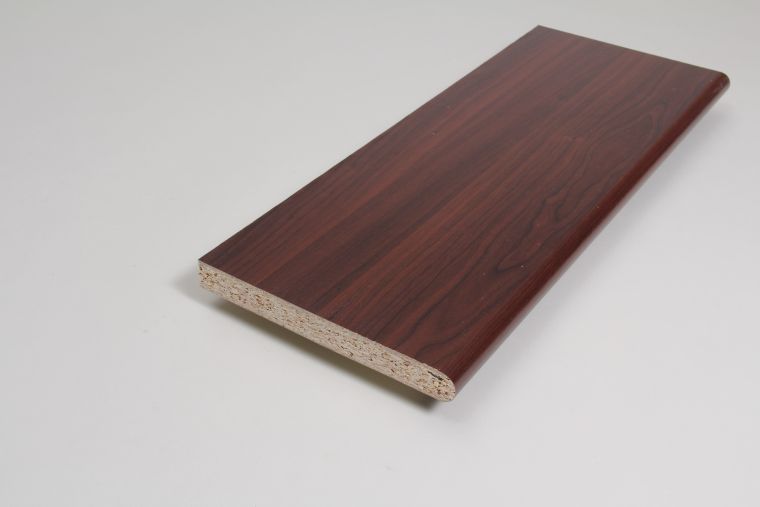
Mahogany is the best choice to bring warmth and vibrancy into an interior. Its reddish-brown and dark accents were highly regarded during Victorian times. So, just like Black Walnut, if you want to revive your decor, this should be your go-to.
At The Skirting Board Shop, you'll find 3 choices of fully-finished Mahogany Foil Wrapped window boards. For a gentle wooden feel, go for the 150 mm sill. For slightly deeper windows or wider overhangs, choose the 180 mm or 200 mm sills.
Even though Mahogany may bring to mind grand, ornamented Victorian interiors, it works out beautifully on contemporary properties. A favourite for floorings, Mahogany window sills will help create a streamlined, nature-inspired style by bringing it all together.
Replacing a Window Sill
The main challenge here is that you are not starting from zero. You need to first get rid of your old mouldings, so being delicate is a must. On this article to removing and replacing interior window sills, you'll find out the tools and easy steps to follow to get the job done in no time.
Fitting a Window Sill
Fitting a window sill is way easier than fitting skirting boards and architraves because there are no joints to mitre. This full guide to fitting window sills will assist your DIY-er quest, so read on!
Painting MDF Window Sills
All the white window sills available at The Skirting Board Shop come already primed, so you can skip this step and jump right into undercoating!
The great advantage of a ready primed board is that the MDF -a highly porous material- comes already sealed. This means it won't absorb the paint in a snap, which could ruin your mouldings.
Ideally, you'd apply two layers of undercoat followed by sanding to achieve a uniform colour and texture. Once the undercoat is ready, use an oil-based paint to finish off your board.
Once your sills have been primed and undercoated, you can choose to use either water-based or oil-based paints. Beware though! Water-based paints have a slight risk of penetrating the MDF fibres if the sealing stage wasn't done right.
It will then come to the sheen you want. The most widely used types for mouldings are semi-gloss and gloss because of their durability and dust repellence, ideal for the high traffic areas around your house.
The Skirting Board Shop's Final Top Tips
To prevent dust settling on your window sills, clean them with a dry microfibre cloth every one or two weeks. To remove stains, simply use water mixed with a little bit of dishwasher and spray it on a cloth till damp!
If you need help choosing your next best window board, get in touch with our experts calling 0800 048 0786, and make the most of our award-winning customer service team. You can also request free samples to decide what will be best for your home. Happy reno!
 0800 048 0786 Monday - Friday, 8:30am to 4pm
0800 048 0786 Monday - Friday, 8:30am to 4pm
